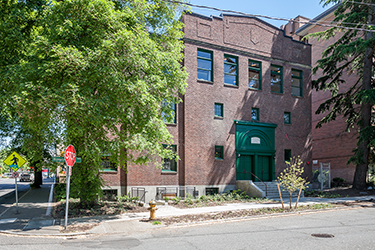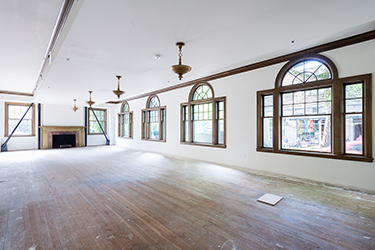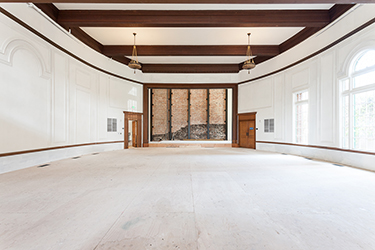|
Subscribe / Renew |
|
|
Contact Us |
|
| ► Subscribe to our Free Weekly Newsletter | |
| home | Welcome, sign in or click here to subscribe. | login |
News
| |
 Brian Miller Real Estate Editor |
July 13, 2017
On the Block: It's showtime again at the Harvard Exit
It's amazing what letting in a little light — no, a lot of light — will do for a dark old movie theater.
Developer Scott Shapiro is touring me through the newly renovated Harvard Exit, at 807 E. Roy St. We're on the top floor, once the smaller of its two cinemas, previously accessible only by a creaky, winding stair. (Some moviegoers will remember that you had to go up those same stairs from the main cinema to find the bathrooms.)
That's all changed since Shapiro's Eagle Rock Ventures LLC bought the three-story building for $2.35 million in January of 2015. The Exit closed that same month, with “The Theory of Everything” its final show.
There's now an elevator, new wiring, seismic bracing and a new HVAC system. The place has been brought up to modern codes. It's ADA compliant. It smells of fresh paint and sheetrock. Everything's shiny and new and waiting for a single tenant, Shapiro hopes, willing to lease all 17,000 square feet.
“We had to put in millions of dollars,” says Shapiro. Construction work started in May of 2016, and took about a year.
Dan Stutz and Evan Steinruck of CBRE are leasing the space, and my advice for showing it to prospective tenants is this: Take them to the top floor first. Sunlight floods through the original windows now reopened on the south and west sides, and the area's low-rise zoning will keep it that way.
With the screening room and backstage areas now cleared, the top floor's 5,200 square feet of open space again resembles the ballroom it once was. The Woman's Century Club constructed the building in 1925. Movie screenings began in 1968, initially in what had been the club's downstairs meeting hall.
The property suffered from deferred maintenance during its long lease to Landmark Theatres. Two locals, Art Bernstein and Jim O'Steen, bought the building in the late 1960s and operated the theater for a decade, then sold the exhibition business to Landmark. (That same company, which cycled through bankruptcy and different owners, recently closed the Seven Gables and Guild 45th, which are expected to be sold and redeveloped into apartments.)
When Shapiro did the walk-through before buying the building, he recalls, “The roof was shot. It was leaking.”
But today, “Basically it's a new building in an old shell. It's a Class A building in an historic shell. It's a unique property in a unique location.”
The familiar old lobby, where the grand piano and comfy chairs once stood, “could be office space, could be a restaurant,” Shapiro says. However, looking south down Broadway, he notes, “There is a lot of retail already.” Speaking of cautious food and beverage mavens, he adds, “They're all kind of wary of where we are in the cycle right now. It's very hard to start a small business in Seattle.” Translation: Using the Exit for office space would likely be quicker and less risky.
So who has Shapiro been talking with? “There's definitely a couple tech folks.”
The Exit's charm and character are big draws, but the downside is a lack of parking. Transit is decent. Capitol Hill Station is only a few blocks south, but plans to extend the city streetcar line to the end of Broadway are still mired in talks with local merchants — who are, as ever, concerned about losing curbside parking.
But Shapiro notes that a business owner who already lives on Capitol Hill would have a short walk or bike ride to the Exit, and get to skip the commute by car.
On levels two and three are five private turnkey offices, ranging from 269 to 619 square feet. One even has a fireplace. “This was originally the caretaker's office,” says Shapiro.
“These are all ready to go,” says Shapiro, though he'd rather try to rent the whole building before leasing out the small offices individually.
Downstairs, in the larger of the two cinemas, the space measures over 4,800 square feet (including the balcony, suitable for conferencing, cubicles or hangout space). The ceiling height is a whopping 23 feet. Above the original stage, which was previously hidden by the movie screen, “You can see the old rigging,” says Shapiro, pointing to the beams overhead.
Tall, south-facing windows make it a bright and cheerful room. Shapiro thinks the Exit is ideal for a tech company, architectural firm or some other design-minded business.
The final paint job and plumbing hook-ups await a customized tenant build-out. Small kitchen areas could be added; and there's already one shower for noontime runners or cycle commuters.
A 1,600-square-foot daylight basement, with a new street entrance and stairs, could be a bar, gym or company bike room, says Shapiro.
In general, the Exit falls into that rare category of boutique office space that's historic, but not run-down-and-decrepit historic (like so much of Pioneer Square). The Exit is not a city landmark, though the renovation employed federal historic tax credits. Wherever possible, says Shapiro, old fixtures, hardware and interior details were preserved.
Shapiro has experience on Capitol Hill, where he and Liz Dunn developed Melrose Market. He also owns the Chop Suey building, at 14th and Madison, though no plans have been floated for that small parcel.
Speaking of Broadway and Capitol Hill in general, says Shapiro, “It's harder for those bigger companies to find those bigger sites.” And those bigger national companies are focused on residential development, like Mill Creek Residential eyeing the Bonney-Watson property, and Equity Residential close to breaking ground on the Piecora's Pizza site.
“There's just not a ton of office” on the hill, says Shapiro. “We have a ton of apartments, but we don't have a balance.”
Shapiro does have a finger in housing, with 49 units underway at 120 10th Ave. E. Otherwise, he's been busy with renovating the Exit.
“I haven't bought anything in Seattle since this building,” he says. “We're long-term. We'll hold onto it.”
The Harvard Exit renovation team included architect SHW (previously called S+H Works); Dovetail General Contractors; Root of Design, landscape architect; Frank Co., structural engineer; Nick Bossoff Engineering, civil engineer: Greenbusch Group, mechanical engineer; PanGEO, geotechnical engineer: and lender Anchor Bank.
Got a tip? Contact DJC real estate editor Brian Miller at brian.miller@djc.com or call him at (206) 219-6517.
Previous columns:
- On the Block: Despite the turmoil, Seattle retail is doing fine, 06-29-2017
- On the Block: A long and winding road to the 128-unit Zella apartments on Lower Queen Anne, 06-15-2017
- On the Block: Coming attractions: What's next for the Guild 45th and Seven Gables theater sites?, 06-08-2017
- On the Block: City's first Living Building apartments: 42 zero-net units planned in Fremont, 06-01-2017
- On the Block: The Spring District is starting to sprout, 05-25-2017
- On the Block: LIHI moving HQ to ID, selling Belltown site, 05-18-2017
- On the Block: Things heat up on a big block in Bellevue, 05-11-2017
- On the Block: Hotel added to Railspur in Pioneer Square, 05-04-2017





